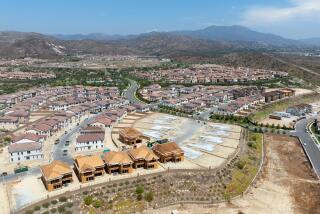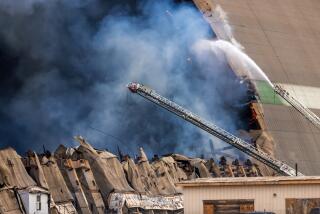Commentary : El Toro Airport Study Is Needed
- Share via
Everybody agrees that Orange County needs another airport. Every study on the subject concludes that even if John Wayne Airport were built to its maximum capacity, it would never serve more than one-third of the county’s demand.
Recently announced action by Congress to have the Federal Aviation Administration study joint civilian use of the U.S. Marine Corps Air Station, El Toro, has been criticized by some as neither useful nor promising. Wrong.
El Toro is a promising site for commercial air service and deserves a fair study.
No study has ever concluded that joint use of El Toro was “technically infeasible.” Rather, all studies have said there are issues that remain to be resolved. Many private aviation experts, the Southern California Assn. of Governments, the Southern California Regional Airport Authority, the Inter-County Airport Authority and the Federal Aviation Administration believe that El Toro has strong potential for civilian use.
A few facts and common sense lead even a layman to the same conclusion.
El Toro has five large runways and only 120,000 aircraft operations (landings or takeoffs) per year. In comparison, John Wayne Airport has only two small runways and 400,000 operations per year.
Commercial airliners have used El Toro for years to ferry troops and refugees, and many military aircraft now using the base are identical to civilian jet aircraft. Tactical military aircraft like those at El Toro regularly train at dozens of civilian airports throughout the country, and civilian use of military air bases occurs at 23 separate locations.
To preserve security and avoid disruption to the military at El Toro, civilian terminal and parking facilities could be located off base on agricultural land lying directly adjacent to the runways. Engineering solutions appear available to solve all technical problems which have been raised in opposition to joint use.
Environmental problems, as well as technological ones, also appear solvable. Traffic and smog would actually decrease; funds would be available for new roadway construction, and noise would be confined to established, undeveloped noise buffer zones.
Traffic and smog would decrease because 8 to 10 million air passengers from south Orange County would not need to drive past El Toro on their way to LAX. Local El Toro traffic would be handled by new off-airport roadways constructed with literally hundreds of millions of dollars of airport funds, as is now occurring near John Wayne Airport.
Noise from joint use would be minimal. Airliners, especially quiet ones like those at John Wayne, are vastly less noisy than military jets. Airlines and aircraft manufacturers have demonstrated that adequately loaded commercial airliners could use the El Toro runways as the military does now to avoid flying over populated areas.
Thousands of acres of open space beneath military flight paths have been preserved as noise and safety buffer zones which are more than adequate for civilian operations. In contrast to John Wayne, where aircraft overfly 15,000 homes within five miles of the runway, no homes would be similarly situated near El Toro.
Controlled growth at El Toro could ensure that the volume of flights and passengers remains at reasonable levels. The limits imposed at John Wayne by the settlement agreement with Newport Beach could be duplicated at El Toro, and a joint powers airport authority including the City of Irvine and others would give adjoining communities lasting control.
The benefits of commercial use of El Toro in terms of economics, convenience and transportation efficiency would be enormous. The huge (40 million square feet) commercial developments approved by the City of Irvine in the Technical Center and Spectrum projects would experience an immediate increase in marketability.
Millions of air passengers from the rapidly growing south county could have a nearby convenient airport. The recently approved multimodal transportation center on the Southern Pacific Railroad tracks abuts El Toro very near to where an off-base civilian terminal might be located. Bus and mass-transit routes could easily include El Toro.
The proposed eastern and foothill corridors as well as the existing Laguna, San Diego, and Santa Ana freeways pass nearby. Experienced business and transportation planners have long recognized these potential benefits.
All these factors argue forcefully for competent, objective study of joint civilian/military use of El Toro by the Federal Aviation Administration, which has the necessary expertise. Whether positive or negative, the study results will help focus the efforts of those who seek to solve Orange County’s air transportation problem. The recent action of Congress mandating the FAA study is welcome and encouraging and deserves support by all concerned.
More to Read
Sign up for Essential California
The most important California stories and recommendations in your inbox every morning.
You may occasionally receive promotional content from the Los Angeles Times.












